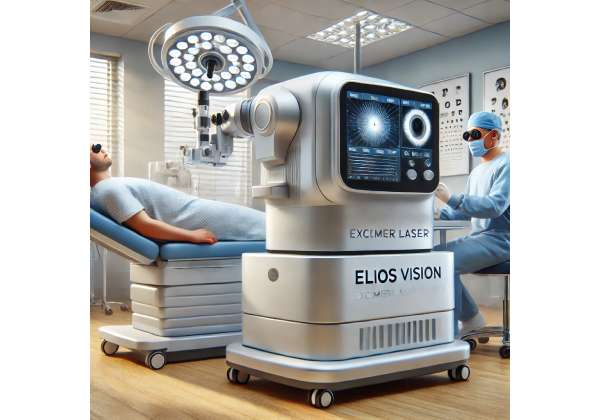Glaucoma continues to be a leading cause of irreversible vision loss worldwide, driving an urgent need for more advanced, effective treatments. Elios Vision represents a state-of-the-art Excimer Laser system designed to reshape and refine modern approaches to glaucoma care. By targeting the trabecular meshwork—the eye’s key drainage area—this innovative technology aims to reduce intraocular pressure (IOP) and slow the disease’s progression. What sets Elios Vision apart is its precision: the laser energy is finely tuned to optimize fluid outflow, potentially helping patients maintain healthier IOP levels with fewer complications. For many, this breakthrough signals a step forward in preserving vision and enhancing quality of life, while paving the way for more personalized, patient-friendly glaucoma care.
Understanding the Science Behind Elios Vision: Key Insights for Glaucoma Management
Glaucoma is commonly linked with increased intraocular pressure, which can damage the optic nerve over time. Historically, treatments have included medications (such as prostaglandin analogs or beta-blockers) and surgical procedures to manage IOP and retard disease progression. However, many of these strategies require long-term daily use or invasive interventions. The advent of minimally invasive glaucoma surgeries (MIGS) marks a new era, offering safer yet impactful outcomes. Elios Vision, as an Excimer Laser platform, fits well within this trend, delivering highly targeted energy to the trabecular meshwork to ease fluid drainage from the eye.
The Anatomy of Aqueous Humor Flow
Aqueous humor is the clear fluid produced by the ciliary body inside the eye. It circulates through the pupil into the anterior chamber, where it drains primarily via the trabecular meshwork into Schlemm’s canal and then into the systemic circulation. In glaucoma, structural changes or blockages in this outflow system lead to elevated intraocular pressure. Over time, this pressure can impair optic nerve function, culminating in progressive vision loss.
- Trabecular Meshwork (TM): A spongy tissue located around the base of the cornea. Its small pores allow the aqueous humor to filter into Schlemm’s canal.
- Schlemm’s Canal: A circular channel that collects the fluid after it passes through the TM.
- Collector Channels: Small conduits branching off from Schlemm’s canal, ultimately merging with veins to return fluid to the bloodstream.
When the TM becomes less efficient or physically blocked by pigment, debris, or tissue remodeling, IOP rises. Chronic elevations in pressure can compress or damage the optic nerve fibers, resulting in the characteristic vision changes associated with glaucoma.
The Excimer Laser Advantage
While several laser procedures exist—like Selective Laser Trabeculoplasty (SLT) or Argon Laser Trabeculoplasty (ALT)—Elios Vision capitalizes on Excimer Laser technology, using ultraviolet light with very short pulse durations. This precision means the laser energy is absorbed in an extremely localized area, minimizing collateral damage to adjacent tissues. The system ablates microscopic amounts of trabecular tissue to restore a healthier outflow pathway. Key benefits include:
- Targeted Ablation: The laser beam vaporizes tissue in a finely controlled manner, allowing smaller, more precise areas of the TM to be treated.
- Minimal Thermal Spread: Excimer lasers operate at shorter wavelengths, generating less heat compared to other laser types, mitigating the risk of collateral thermal damage.
- Repeatability: In some instances, the procedure can be repeated if needed to maintain or enhance long-term outcomes.
How Elios Vision Works
Elios Vision specifically emits a 308-nanometer wavelength of ultraviolet light. This high-energy beam can precisely “excavate” or remodel sections of the trabecular meshwork without significantly impacting surrounding structures. The technique typically involves:
- Targeting: The surgeon visualizes the TM through a gonioscope, ensuring precise placement of the laser energy.
- Pulsed Delivery: Short bursts of laser energy are applied to create microchannels within the TM, improving aqueous humor outflow.
- Immediate Fluid Egress: Once these new channels are formed, fluid can drain more efficiently, reducing intraocular pressure.
Clinical studies suggest that this approach not only lowers IOP but also has a minimal adverse effect profile. Additionally, because Excimer Laser energy is inherently gentle on surrounding tissue, patients often experience fewer complications such as post-procedure inflammation or scarring.
Linking Science to Outcomes
At its core, glaucoma management is an exercise in preserving the delicate balance between aqueous humor production and drainage. With Elios Vision, the emphasis shifts toward making subtle, precise alterations to the drainage pathway while reducing trauma to the eye. In contrast to more invasive incisional surgeries like trabeculectomy or tube shunt placements, patients may experience reduced discomfort, quicker recovery times, and fewer follow-up interventions.
For ophthalmologists, the technique offers a blend of predictability and adjustability: the surgeon can modify the area and depth of ablation based on patient-specific anatomy. Early research has shown that patients with open-angle glaucoma, the most common form, are prime candidates for this technology. They often see consistent declines in intraocular pressure and reduced dependence on daily glaucoma eye drops.
Building on Established Laser Modalities
Excimer Laser technology is not entirely new—it has been employed in corneal refractive procedures (e.g., LASIK, PRK) for many years. Its transition into the realm of glaucoma care, however, heralds an evolution in how eye specialists view laser-based therapies. Instead of relying on thermal or photocoagulative effects to achieve tissue changes, the submicron precision of the Excimer beam harnesses photochemical tissue ablation, avoiding the need for large, energy-intensive pulses.
In short, the science of Elios Vision leverages tried-and-true aspects of Excimer Laser technology—familiar from corneal surgeries—to craft a novel, minimally invasive approach to open-angle glaucoma. By integrating advanced imaging, sophisticated targeting, and an improved safety profile, this platform is poised to become a key instrument for eye care professionals seeking to optimize patient outcomes.
Why This Matters for Patients
At the individual patient level, reducing the number of medications or delaying invasive surgery can significantly enhance quality of life. Many people struggle with medication compliance due to cost, side effects, or simple forgetfulness. Others may not be ideal candidates for traditional surgeries, either because of personal health factors or concerns about extended healing times. Offering a middle-ground intervention that is both safe and capable of significant IOP reduction addresses a longstanding therapeutic gap in glaucoma care.
Practical Implementation: How Elios Vision Fits into Modern Glaucoma Treatment Protocols
Guidelines for glaucoma management emphasize personalized care based on disease stage, patient lifestyle, and overall risk. Most treatment pathways begin with medication, and, when necessary, escalate to laser therapy or surgery if pressures remain uncontrolled. Elios Vision offers a new dimension of flexibility in these protocols, providing an option that is minimally invasive yet potent enough to bring about meaningful decreases in IOP.
Patient Selection Criteria
Certain characteristics make patients ideal candidates for Elios Vision:
- Open-Angle Glaucoma: While angle-closure glaucoma involves anatomical blockages of the drainage angle, open-angle varieties are more responsive to procedures that enhance outflow through the trabecular meshwork.
- Mild-to-Moderate Disease Stages: At these stages, enough functional TM remains to benefit from the micro-ablation. Advanced or end-stage glaucoma may still require more traditional, filtering-based surgeries.
- Medication Tolerance Issues: Patients who struggle with side effects or adherence to daily drop regimens may find significant relief in an intervention that can lessen their medication load.
- Desire for Fewer Invasive Procedures: Individuals who are reluctant to pursue incisional surgery (e.g., trabeculectomy) but desire more robust results than standard laser trabeculoplasty can achieve.
Procedure Steps and Clinical Setting
Elios Vision typically takes place in an outpatient setting or an ambulatory surgery center under topical or local anesthesia. A mild sedative may be administered to help patients relax. Here is a simplified overview of the procedure:
- Preoperative Preparation: The surgical team checks the patient’s intraocular pressure, ensures no active eye infection, and administers anesthetic drops.
- Gonioscopic Visualization: The surgeon uses a goniolens or gonioscope for a clear view of the TM.
- Laser Application: Pulsed Excimer Laser energy is delivered to the TM via a specially designed probe or fiber. The surgeon carefully creates microchannels in a segmental or circumferential manner.
- Postoperative Care: The patient may be prescribed anti-inflammatory or antibiotic drops to prevent infection and reduce inflammation. Follow-up visits measure IOP and gauge the eye’s healing response.
Combining with Other Therapies
One of the strengths of Elios Vision is its ability to integrate seamlessly with existing glaucoma treatments. For instance, patients on prostaglandin analog eye drops might continue using them for a few weeks postoperatively, gradually tapering off if IOP remains at desired levels. Additionally, those who have previously undergone SLT or MIGS procedures may still qualify for Excimer Laser ablation if residual IOP elevation persists.
Clinicians frequently design treatment plans that include multiple modalities, especially for patients with moderate-to-severe disease. Elios Vision can thus be part of a multi-step strategy:
- Medication + Excimer Laser: Ideal for medication-intolerant patients who still require partial pharmacologic support.
- Laser + Microstent Placement: In certain circumstances, surgeons might combine Elios Vision with the implantation of tiny drainage devices to maximize IOP reduction.
- Sequential Surgeries: When a patient’s response to the first round of laser therapy is suboptimal, surgeons can repeat or supplement the treatment without incurring extensive tissue trauma.
Perioperative Care and Follow-Up
Following an Elios Vision procedure, patients typically undergo:
- Frequent IOP Checks: Immediately after surgery, then at one week, one month, and three-month intervals to gauge stability.
- Medication Adjustment: Eye drops, particularly steroids or nonsteroidal anti-inflammatory drugs (NSAIDs), might be prescribed for several weeks to manage inflammation and ensure proper healing.
- Lifestyle Factors: Educating patients on limiting strenuous activities for a short period and recognizing early signs of potential complications (e.g., persistent eye pain, redness, or fluctuating vision).
Because the intervention is minimally invasive, many individuals notice a quicker recovery than with more extensive glaucoma surgeries. Visual function often stabilizes within days to a few weeks, and post-surgical pain levels are commonly described as mild.
Patient Counseling and Expectations
Setting realistic goals is essential for long-term success:
- IOP Reduction: Although significant decreases in pressure are possible, results vary by individual. Patients should understand that ongoing monitoring is necessary.
- Potential for Fewer Drops: Many patients can reduce the number of glaucoma medications postoperatively, but not all will eliminate drops entirely.
- Maintenance of Surgical Benefits: Over time, the microchannels created by the laser may experience some scarring, which could diminish their effectiveness. In such cases, repeat procedures or supplementary treatments might be needed.
By seamlessly fitting into existing treatment protocols, Elios Vision has the potential to bridge the gap between medical therapy and more invasive surgical interventions, offering a balanced, patient-friendly approach to managing one of the world’s most pervasive eye conditions.
Latest Research Insights: Evaluating Clinical Data on Elios Vision
Ongoing clinical trials and published studies underscore the safety and effectiveness of Elios Vision in lowering intraocular pressure for open-angle glaucoma. Researchers have focused not only on short-term IOP reductions but also on long-term stability, quality of life, and complication rates.
Key Clinical Studies and Their Findings
- Multicenter, Prospective Trial
- Participants: 200 patients with mild to moderate open-angle glaucoma who were either poorly controlled on medications or seeking a less invasive option than trabeculectomy.
- Method: The participants underwent Elios Vision Excimer Laser therapy, followed by regular follow-ups over 18 months.
- Results: Approximately 70% achieved IOP reductions of at least 25% from baseline, and over half reduced at least one medication class. Complications were minimal, with transient inflammation being the most frequently noted issue.
- Comparative Study with Other Laser Techniques
- Goal: Evaluate differences in IOP control between Elios Vision, Selective Laser Trabeculoplasty (SLT), and Argon Laser Trabeculoplasty (ALT).
- Finding: While SLT and ALT also lowered IOP, Excimer Laser therapy demonstrated more consistent mid- to long-term maintenance of improved outflow, attributed to the precise photochemical ablation of trabecular tissue.
- Longitudinal Observational Research
- Population: 80 patients with POAG (Primary Open-Angle Glaucoma) who opted for Excimer Laser ablation over conventional surgical treatments.
- Observations: Over a two-year period, nearly 60% sustained meaningful IOP reduction (>20% decrease) without requiring additional invasive procedures. Quality of life measures improved, as many participants needed fewer daily drops and reported fewer side effects.
These studies collectively highlight how Elios Vision can offer both immediate and lasting benefits, making it a compelling option for physicians and patients alike.
Mechanistic Insights from Research
Several investigations delve deeper into the mechanism by which Excimer Laser pulses create microchannels in the trabecular meshwork:
- Biopsy Analyses of removed tissue demonstrate minimal collateral damage and sharply defined ablation zones.
- In Vivo Imaging techniques, such as anterior segment optical coherence tomography (AS-OCT), show newly formed outflow pathways within days of treatment.
- Fluid Dynamic Models predict better distribution of aqueous humor flow, suggesting that improved drainage may persist for extended periods if scarring is minimal.
This emerging body of research underscores that the success of Elios Vision hinges on its unique ability to precisely ablate tissue without unleashing extensive thermal energy—a factor that separates Excimer Laser procedures from other, often more invasive, glaucoma interventions.
Safety Profile in Published Data
Clinical evaluations often emphasize safety, given the eye’s sensitivity and the potential for complications that could worsen a patient’s condition. Across various studies:
- Transient Inflammation: Mild to moderate intraocular inflammation is common but typically resolves quickly with prescribed topical steroids.
- IOP Spikes: In some cases, patients experienced temporary IOP elevations immediately after the procedure; these spikes were usually controlled with short-term medication.
- Rare Complications: Incidences of significant corneal endothelial cell loss or severe hyphema (bleeding in the anterior chamber) were reported in less than 2% of patients.
Overall, the consensus is that Elios Vision brings a favorable risk-benefit ratio. Many ophthalmologists find it reassuring that complications, when they do occur, are often transient and manageable with timely intervention.
Long-Term Prognosis and Future Directions
While short-term outcomes appear robust, especially in mild-to-moderate cases, long-term data are still accumulating. Some experts anticipate that the results from ongoing large-scale trials—spanning three to five years—will better define the durability of pressure control and specify ideal retreatment intervals. There is a growing trend toward combining Excimer Laser therapy with real-time imaging technologies or advanced drug-delivery implants to further elevate patient outcomes.
Potential Innovations on the Horizon
- Personalized Laser Profiles: Ongoing research aims to tailor the laser energy pulses to individual anatomical variations in the trabecular meshwork.
- Biomarker-Driven Treatment: Scientists are investigating molecular markers that indicate which patients might respond most favorably to Excimer Laser therapy.
- Integration with Other MIGS: Combining mini-stents or shunts with Elios Vision in a single procedure could produce more robust IOP control, particularly in borderline severe glaucoma cases.
In essence, the research landscape supports the notion that Elios Vision not only competes with other laser-based therapies but also fills a unique niche in glaucoma care by merging high precision with minimal tissue trauma. As more data emerges, the therapy’s role could expand into earlier intervention or even prophylactic use in high-risk ocular hypertension cases.
Examining Effectiveness and Safety: Ensuring the Best Possible Outcomes
When introducing new or evolving technology into clinical practice, both effectiveness and safety must be thoroughly scrutinized. For Elios Vision, the promise of sustained IOP reduction with minimal invasiveness positions it as a game-changer in glaucoma management. However, no procedure is completely risk-free, and clinicians must evaluate potential trade-offs based on each patient’s unique presentation.
Efficacy Considerations
- Significant Pressure Reduction: In numerous studies, Elios Vision has demonstrated consistent IOP drops in the range of 20–30%. This range often leads to clinically meaningful preservation of vision by slowing optic nerve damage.
- Medication Burden: A notable proportion of patients either reduce or eliminate one or more classes of glaucoma eye drops, which can enhance adherence and reduce cumulative side effects.
- Consistency Over Time: Many individuals maintain lower pressures for at least one to two years, although the durability of these results can vary.
Patient Factors That Influence Success
Not all patients respond to Elios Vision with the same degree of IOP improvement. Critical factors include:
- Disease Severity: Advanced-stage glaucomas with extensive optic nerve damage may not experience as robust an improvement.
- Ocular Anatomy: Variations in the eye’s anterior segment or drainage angle can limit how effectively the laser can reach the TM.
- Comorbidities: Conditions such as severe corneal dystrophy, uveitis, or prior extensive surgical history can reduce the procedure’s effectiveness or complicate the recovery process.
- Biological Variability: Some individuals may have a naturally higher propensity for scarring or poor wound healing, affecting long-term success.
Balancing Safety and Potential Risks
Elios Vision distinguishes itself via a relatively mild postoperative profile. Yet, patients should be aware of possible risks:
- Mild Pain or Discomfort: Typically managed with over-the-counter analgesics or short-term prescription medications.
- Transient Redness: Subconjunctival hemorrhages or localized inflammation are not uncommon but tend to resolve spontaneously.
- Rare Complications: More serious complications like endophthalmitis (intraocular infection) or persistent corneal edema are very uncommon but can occur with any ocular intervention.
Minimizing Complication Rates
Ensuring a low-risk profile for Elios Vision involves:
- Proper Patient Screening: Comprehensive preoperative evaluations help identify contraindications, such as narrow angles or advanced keratitis.
- Expert Surgical Technique: Trained ophthalmologists with experience in microinvasive laser procedures significantly reduce the chance of complications.
- State-of-the-Art Equipment: Calibrated, well-maintained lasers with built-in safety features lower the risk of inaccurate tissue ablation.
- Proactive Postoperative Follow-Up: Early detection of rising IOP or inflammation can prevent more serious issues from developing.
Quality of Life and Patient Satisfaction
Beyond numerical reductions in IOP, many patients report enhanced day-to-day well-being, reduced anxiety about missing eye drops, and fewer medication-related side effects such as ocular dryness or redness. Additionally, for patients who previously faced steep medical costs, fewer prescriptions can alleviate financial burdens. These intangible benefits, while harder to measure in clinical trials, play a pivotal role in driving patient acceptance and satisfaction with the procedure.
Incorporating Elios Vision into the Larger Glaucoma Toolkit
It’s important to note that while Excimer Laser therapy may offer a substantial leap forward, it does not render other treatments obsolete. Rather, it provides a vital and versatile tool that physicians can tailor to each patient’s situation. For some, combining this technology with medications or other MIGS will produce optimal outcomes. For others, Elios Vision can serve as a standalone intervention that holds off more invasive surgeries for years.
The overarching message is clear: with careful patient selection, precise surgical execution, and diligent follow-up, Elios Vision stands as a safe and effective option in the evolving landscape of glaucoma therapies.
Therapy Price: Considering Budget and Financing for Elios Vision
Costs for Elios Vision vary by region, clinic expertise, and the extent of pre- and postoperative care. A single procedure may range from a few thousand to several thousand dollars, factoring in surgeon fees, facility charges, and any required diagnostic imaging. Some insurance plans provide partial coverage if the treatment is deemed medically necessary. Certain eye centers offer package deals that bundle follow-up care and potential retreatments at reduced rates. Patients who require financing can explore medical loan options or inquire about in-house payment plans, which allow the total cost to be spread over several months or more.
Disclaimer: This article is for informational purposes only and does not substitute professional medical advice, diagnosis, or treatment. Always consult qualified healthcare professionals for personalized guidance on eye health and any medical procedure.
We encourage you to share this article to help others learn about Elios Vision and its potential benefits. Use our convenient Facebook and X (formerly Twitter) share buttons or any other preferred method—your support can make a difference in raising awareness and preserving vision.

















